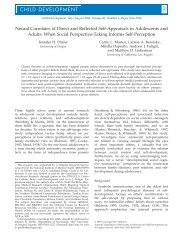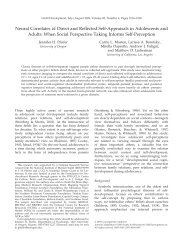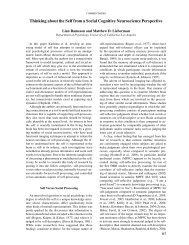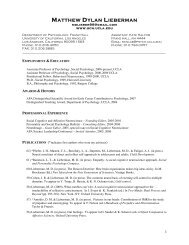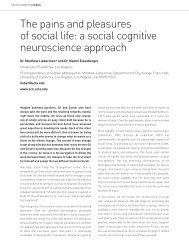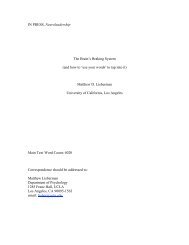In Progress – DO NOT CITE Attributional inference across cultures ...
In Progress – DO NOT CITE Attributional inference across cultures ...
In Progress – DO NOT CITE Attributional inference across cultures ...
Create successful ePaper yourself
Turn your PDF publications into a flip-book with our unique Google optimized e-Paper software.
Culture, Attribution, & Automaticity<br />
30<br />
attribution would be made. <strong>In</strong> study 3, we pitted these two potential processes against<br />
one another by providing situational constraint information that implied a stronger<br />
disposition rather than a weaker disposition.<br />
Based on our results we may speculate whether previous studies have actually<br />
shown greater sensitivity to situational information when the information is made salient.<br />
It is possible that the salience manipulation in those studies activated the situationalist<br />
theory of behavior for EA participants, leading them to more readily apply a situational<br />
causality heuristic, rather than leading them to attend more closely to the actual<br />
situational information. It remains for future studies to determine the effect of<br />
simultaneously varying the salience and the inferential implication of the situational<br />
information. We acknowledge that it is equally plausible that in high salience conditions,<br />
actual sensitivity to situational information would override a situational causality<br />
heuristic. Nevertheless, low salience conditions dominate daily life, supporting the real<br />
world significance of our findings.<br />
Limitations<br />
There were a number of limitations of studies 1-3 that could diminish the<br />
inferential power of these studies. Four of these limitations were addressed in studies 4<br />
and 5. First, in studies 1-3, all participants made ratings of a US target. Thus,<br />
participants not only varied with respect to culture but also with respect to the match<br />
between their culture and the target’s culture. It is not unreasonable to assume that<br />
participants would recruit different mental processes or have different levels of<br />
confidence when making ratings of a target that is from a more familiar culture.



